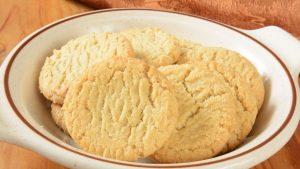Baking is a universal language of comfort and delight, but for those with gluten intolerance or celiac disease, the traditional recipes often pose a culinary challenge.
In this post, we delve into the intriguing world of gluten-free cookies. We’ll uncover the unique techniques, ingredients, and science behind baking these delectable treats, shedding light on why they require a special touch.
Join us on this flavorful journey as we answer the question: Are gluten-free cookies baked differently, and why does it matter?
Baking Beyond Wheat: The Secrets Behind Gluten-Free Cookies and Their Unique Process.
Gluten-free cookies can be baked just like regular cookies, but there are some key differences in the ingredients and techniques used due to the absence of gluten.
Gluten is a protein found in wheat, barley, and rye, and it plays a crucial role in traditional cookie recipes by providing structure and elasticity to the dough.
Here’s how gluten-free cookies are baked and why:
Gluten-Free Flour: Instead of regular wheat flour, gluten-free cookies use a combination of gluten-free flours such as rice flour, almond flour, coconut flour, or a commercial gluten-free flour blend.
These flours do not contain gluten and are used to replace traditional wheat flour.
Binding Agents: Because gluten provides elasticity and helps hold the cookie dough together, gluten-free recipes often require additional binding agents.
Common choices include xanthan gum or guar gum. These ingredients help mimic the binding properties of gluten.
Liquid Ratios: Gluten-free flours may absorb liquid differently than wheat flour. You may need to adjust the amount of liquid in the recipe to achieve the right consistency.
Sometimes, a bit more liquid is needed in gluten-free cookie dough to prevent it from becoming too dry and crumbly.
Leavening Agents: Baking powder and baking soda are often used as leavening agents in gluten-free cookies to help them rise since gluten-free flours can be denser than wheat flour.
Texture: The texture of gluten-free cookies may be different from traditional cookies. They may be more crumbly or have a slightly different texture due to the absence of gluten.
This is why additional ingredients like xanthan gum or eggs are often used to improve texture.
Flavorings and Mix-Ins: Gluten-free cookies can incorporate various flavorings and mix-ins just like regular cookies.
Common additions include chocolate chips, nuts, dried fruits, or spices to enhance the taste.
Baking Time and Temperature: Gluten-free cookies are typically baked at the same temperatures as regular cookies, but the baking time may vary. You might need to monitor them closely to avoid overbaking, which can make them dry.
In other words, gluten-free cookies can be baked successfully by using a combination of gluten-free flours, binding agents, and leavening agents to compensate for the absence of gluten.
Careful attention to the recipe, ingredients, and baking techniques is essential to achieve delicious gluten-free cookies with the right texture and flavor.

Let’s dig deeper: explaining Further why baking gluten-free cookies.
let’s dive deeper into each of these aspects of baking gluten-free cookies:
Gluten-Free Flour:
Rice Flour:
Rice flour is made from finely ground rice grains. It is a common gluten-free flour and is often used in combination with other flours because it has a neutral flavor and a fine texture.
It’s versatile and can be used in a variety of recipes.
Almond Flour:
Almond flour is made from blanched almonds that have been ground into a fine powder.
It adds a nutty flavor and moisture to gluten-free cookies. It’s a good source of healthy fats and protein.
Coconut Flour:
Coconut flour is derived from dried, defatted coconut meat. It’s highly absorbent, so you’ll need to use it in smaller quantities compared to other flours.
It imparts a subtle coconut flavor and can result in a slightly denser texture.
Commercial Gluten-Free Flour Blend:
Many companies produce pre-made gluten-free flour blends. These blends are designed to mimic the properties of all-purpose wheat flour and are convenient for baking. They often contain a mix of rice flour, tapioca starch, potato starch, and other ingredients to achieve a balanced texture and flavor.
Binding Agents:
Xanthan Gum:
Xanthan gum is a common binding agent in gluten-free baking. It is a natural thickener made from fermented sugars.
In cookie recipes, it helps create a cohesive dough and prevents it from falling apart. Only a small amount is needed, usually about 1/4 to 1/2 teaspoon per cup of gluten-free flour.
Guar Gum:
Guar gum is another binding agent often used in gluten-free baking. It is derived from guar beans and has similar properties to xanthan gum.
It helps improve the texture and structure of gluten-free dough and baked goods.
Liquid Ratios:
When using gluten-free flours, it’s essential to be mindful of the liquid ratios in your recipes.
Gluten-free flours can absorb moisture differently than wheat flour, which can affect the consistency of the dough.
If your gluten-free cookie dough appears too dry and crumbly, you may need to add a bit more liquid.
This can be in the form of water, milk, eggs, or other liquids specified in the recipe. Gradually add liquid until the dough reaches the desired consistency, which should be moist enough to hold together but not overly wet.
It’s a good practice to follow a trusted gluten-free cookie recipe initially and then make adjustments based on your experience and preferences.
In essence, gluten-free flours like rice, almond, and coconut flours are used as alternatives to wheat flour, while binding agents like xanthan gum and guar gum help maintain the structure of the dough.
Adjusting liquid ratios is important to achieve the right dough consistency when baking with gluten-free flours, as they can behave differently than wheat flour.
By understanding these elements and experimenting with different gluten-free ingredients, you can create delicious gluten-free cookies.
Leavening Agents:
Baking Powder and Baking Soda:
Leavening agents like baking powder and baking soda are essential in gluten-free cookie recipes. They create bubbles of carbon dioxide gas when exposed to moisture and heat, causing the cookies to rise and become lighter.
In gluten-free baking, where the absence of gluten can result in denser textures, these leavening agents help provide some of the lift and tenderness that gluten would typically contribute.
Texture:
Gluten-free cookies often have a different texture compared to traditional cookies that contain gluten.
This difference is primarily due to the absence of gluten, which provides elasticity and structure. Gluten-free cookies can be more crumbly or fragile.
To improve texture, additional ingredients are often used:
Xanthan Gum or Eggs:
As mentioned earlier, xanthan gum is a common choice to mimic the binding properties of gluten. Eggs also serve as binders and can enhance the texture of gluten-free cookies, making them less crumbly.
Fats:
Adding a bit more fat, such as butter or oil, can also help improve the tenderness and moisture content of gluten-free cookies, which can counteract the dryness associated with some gluten-free flours.
Flavorings and Mix-Ins:
Gluten-free cookies can be just as flavorful and varied as traditional cookies. You can incorporate a wide range of flavorings and mix-ins, such as:
Chocolate Chips:
Semi-sweet or dark chocolate chips can add richness and sweetness to gluten-free cookies.
Nuts:
Chopped nuts like almonds, walnuts, or pecans provide crunch and a nutty flavor.
Dried Fruits:
Raisins, cranberries, or apricots can introduce sweetness and chewiness.
Spices:
Ground cinnamon, nutmeg, or vanilla extract can enhance the flavor profile of gluten-free cookies.
Baking Time and Temperature:
Gluten-free cookies are typically baked at standard oven temperatures, usually around 350°F (175°C). However, the baking time may vary compared to traditional cookies.
Gluten-free cookies can often bake faster than their gluten-containing counterparts.
It’s crucial to monitor them closely, especially during the last few minutes of baking, to prevent overbaking. Overbaking can result in dry and brittle cookies.
Keep a watchful eye on the cookies, and when they start to turn golden brown around the edges and appear set in the center, they are likely done.
Use visual cues and perhaps perform a touch test to determine their readiness.
In summary, leavening agents like baking powder and baking soda help gluten-free cookies rise and become lighter.
The texture of gluten-free cookies can be improved by using binding agents like xanthan gum, eggs, and slightly more fat. Additionally, you can enhance the flavor with various mix-ins and spices.
When baking, be attentive to avoid overbaking, as gluten-free cookies may bake faster than traditional ones.
A complete tabular on this topic here.
Here’s a comprehensive table summarizing the key aspects of baking gluten-free cookies and why these considerations are important:
| Aspect | Why It Matters |
|---|---|
| Gluten-Free Flour | Gluten-free flours (e.g., rice, almond, coconut) are used to replace wheat flour for those with gluten intolerance or celiac disease. They lack gluten, which can trigger adverse reactions. |
| Binding Agents | Gluten-free recipes often require binding agents like xanthan gum or guar gum to mimic the elasticity and structure that gluten provides in traditional cookies. |
| Liquid Ratios | Gluten-free flours can absorb liquid differently, affecting dough consistency. Adjusting liquid ratios ensures the right texture and prevents dryness. |
| Leavening Agents | Baking powder and baking soda provide lift and lightness to gluten-free cookies, compensating for the denseness of gluten-free flours. |
| Texture | Gluten-free cookies may have a different texture (e.g., crumbly) due to the absence of gluten. Ingredients like xanthan gum, eggs, and fats can improve texture. |
| Flavorings and Mix-Ins | Flavorings like vanilla extract and mix-ins such as chocolate chips or nuts add variety and enhance the taste of gluten-free cookies. |
| Baking Time and Temperature | Monitoring baking time is crucial to prevent overbaking, which can result in dry gluten-free cookies. Baking at standard temperatures (e.g., 350°F or 175°C) is common. |
Understanding and carefully addressing these factors is essential to achieve delicious gluten-free cookies that have the right texture, taste, and consistency.
Final words.
In conclusion, gluten-free cookies are baked with special considerations because they lack gluten, a crucial protein found in wheat.
To compensate for this absence, gluten-free recipes use alternative flours, binding agents, and leavening agents to achieve the desired texture and rise.
Monitoring baking time and temperature is crucial to prevent overbaking and maintain moisture.
Additionally, flavorings and mix-ins are used to enhance the taste, making gluten-free cookies just as delicious as their traditional counterparts.

Whether you’re a passionate baker or simply seeking sweet inspiration, I’m here to provide you with valuable insights, mouthwatering recipes, expert tips, and more to make your cookie adventures with Mike truly delightful and scrumptious. You are on the true exciting cookie-filled side.




